Tigridia (lat. Tigridia ) is a perennial bulbous crop, a representative of the Kasatikovye family. The genus includes more than fifty records. Most of them are naturally found in Mexico and other hot tropical countries. The name of the plant in Latin means “tiger”, which is due to the peculiar color of the perianths. The flower has been cultivated since the 16th century. It is valued not only for beautiful colorful buds, but also for their medicinal properties.
Description
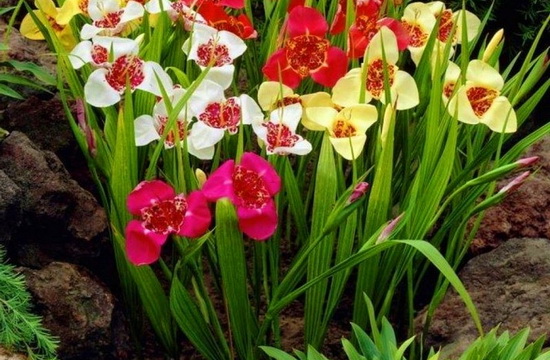
Tigridia is a plant with straight, unbranched stems up to 50 cm high. It has folded xiphoid leaves of a light and rich green color. Their length can be 30 – 40 cm. No more than 3 leaf blades develop on one bush.
The bulbs are rounded, slightly elongated in the upper part, medium in size. Flowers up to 15 cm in diameter, consist of 6 petals, 3 of which are larger and more expressive than the rest. The color of the buds is very diverse. The petals of most varieties are monochromatic. In the center of the bud there are many bright contrasting spots.
This culture begins to bloom in mid-summer. Flowering continues until September. The life span of an opened flower is 8 hours. After the buds wither, new inflorescences soon appear on the plant.
The fruit is a box with triangular, flat seeds.
Species and varieties
Tigridia matudae. The most spectacular type of tigridia. Reaches about 80 cm in height. It has xiphoid straight leaves of intense green color scheme. The flowers are lilac, with many small blurry spots. The buds consist of three large oval petals and the same number of small triangular ones. The diameter of the opened bud is 3 cm.

Tigridia philipiana. A medium-sized variety 25–40 cm high. The leaves are wide xiphoid, slightly bent back, light green in color. The flowers are pale yellow, fading to white. The central part is decorated with a yellow-purple pattern.

Tigridia arequipensis. Unusual appearance with a height of 70 – 95 cm. Flowers with short petals of white, purple, pale yellow. Petals are at some distance from each other.
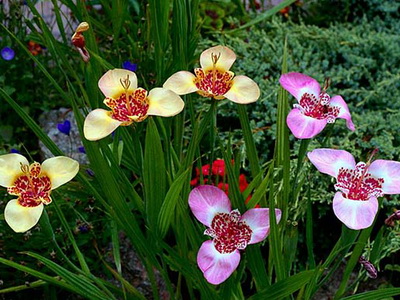
Tigridia chiapensis. A plant 35 – 45 cm high with a straight stem and ribbed narrow foliage. The petals are oval, elongated, snow-white, with a yellow central part, decorated with brown dots.
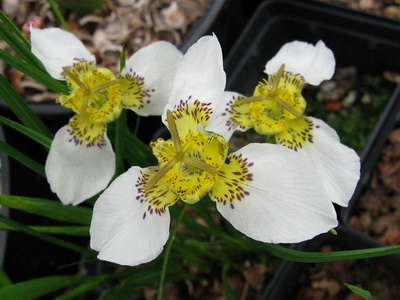
Tigridia pavonia (Tigridia Peacock). The only species used in ornamental gardening. The plant is a dense shrub 40–50 cm high. The corms are obovate, small in size, up to 4 cm in diameter, covered with many membranous scales. Leaf plates are belt-like, wide, dense, bright green. The flowers of Pvlinya tigridia are distinguished by a rich palette of colors, depending on the variety. Flowering begins in July, lasts for two months. The buds open in succession.

Varieties of Peacock Tigrilia:
“Alba” – a spectacular flower with snow-white petals. In the central part of the buds there are burgundy spots.

“Lilation” – distinguished by bright purple petals. The central part of the bud is white with purple spots.
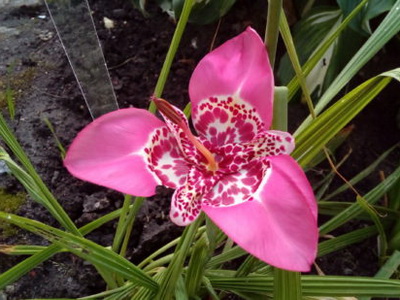
“Aurea” – a variety with buds of a rich yellow color. Their central part is dotted with red spots.
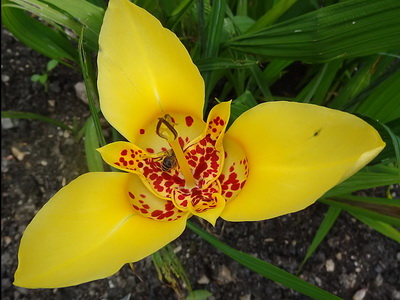
“Spesiosa” – a plant with scarlet petals. The center of the flower is decorated with a yellow pattern.
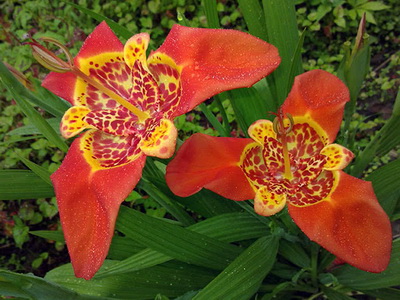
“Rosalind” – a variety with piercing pink inflorescences.

“Canariensis” – petals of carmine color. Central part with numerous scarlet spots.
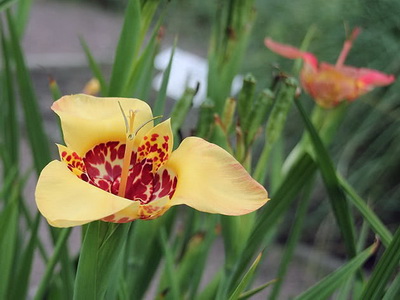
“Mix” – a varietal mixture with buds of various colors. Each flower is beautiful and expressive in its own way. Suitable for creating colorful flower beds.
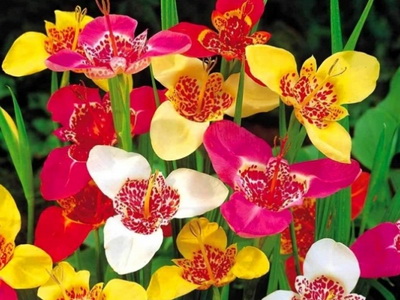
These photos illustrate the description of tigridia of various species and varieties:
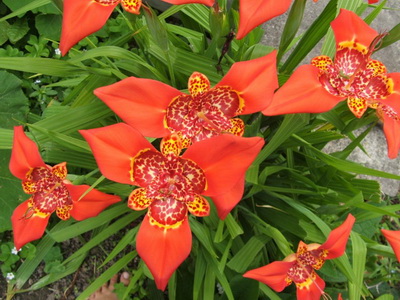

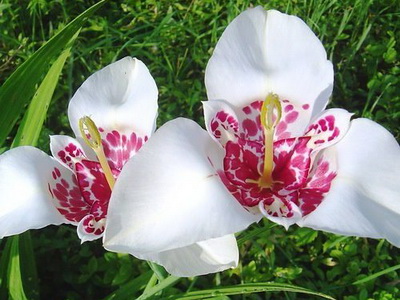
Planting bulbs
Tigridia is obtained with the help of bulbs, which are planted on the site with the onset of warm spring days. The soil should be well warmed up, and the spring frosts should be left behind. It is recommended to plant this culture where it will be constantly under the sun’s rays, otherwise the plant will not demonstrate its unique beauty.
It is important to choose a place where the flower will be protected from strong gusts of wind and drafts. High grades will need to be tied to supports over time. Before embedding in the soil, the bulbs are treated in the Maxim solution to prevent damage by harmful insects and certain diseases.
For planting the bulbs, work is done to prepare the site. The soil is dug up, loosened, weeds are removed, enriched with mineral fertilizers. Planting material is buried by 5 – 10 cm, depending on its size, after which the ground is leveled.
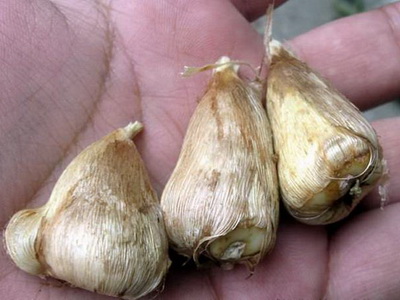
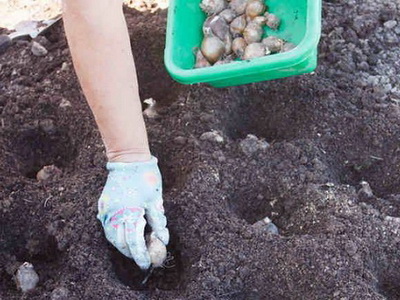
Sprouts will appear in 1 – 1.5 months. Flowering of young plants will begin in the last summer month.
Reproduction by seeds
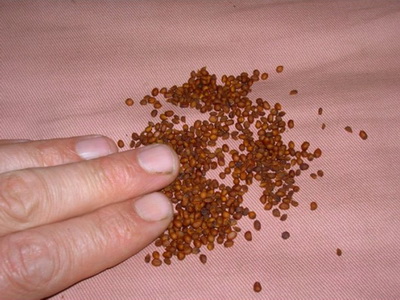
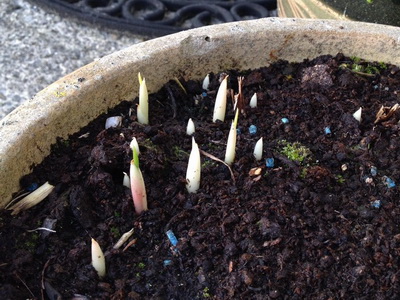
The seed method for obtaining tigridia is used extremely rarely, since it is rather painstaking and time-consuming. After harvesting, the seed is immediately planted in containers without any prior preparation.
After sowing, water, cover with a film. Keep in a bright room with a temperature of 23 – 25 degrees. After the emergence of seedlings, the shelter is removed. Grown plants dive very carefully so as not to damage the fragile roots.
Plants obtained by this method begin to bloom six months after planting.
Care
Plant care is simple and easy, you only need to follow the standard rules of agricultural technology. In response, the plant will respond with the abundant formation of luxurious buds.
- The soil. The soil for growing a bulbous tigridia flower should be light, loose, well breathable, with a neutral acid reaction. If the substrate in the area is dense, river sand must be added.
- Watering. This plant can be classified as moisture-loving. It cannot successfully develop with poor watering. It is required to irrigate the bushes every other day on clear, fine days. In rainy weather, water procedures are not necessary. On hot days, it is recommended to spray the foliage from the sprayer. This work should be carried out in the evening hours, otherwise the sun’s rays will burn the wet foliage.
- Topdressing. Fertilization is required only if the soil on the site is depleted. Tigridia is enough to feed 3 times per season, using any mineral composition for garden flowers. The first top dressing should be made a month after the formation of leaf plates. The second – during the budding period, the third – at the end of flowering.
- Other activities. To grow a healthy tigridia, as in the care of other plants in the open field, after planting and each irrigation, you need to loosen the ground around the bush, as well as eliminate weeds.
- Preparing for the winter. This culture does not tolerate frost, therefore, in regions with severe winters, the bulbs are dug out of the ground with the onset of autumn and brought into a room with a temperature of 5 – 15 degrees. You can dig up corms only after the leaves on the plant are completely dry. During this time, they have time to mature. After digging, the planting material is cleaned from the ground, washed, treated with a solution of the drug “Maxim” and dried well. Store in containers with peat or sand, or in paper bags.
Forcing bulbs
To achieve early flowering, tigridia bulbs are germinated in pots. For their planting, they take spacious containers, which are filled with a nutritious breathable substrate. The distance between the bulbs should be 7 – 10 cm. 2 – 3 bulbs can be planted in one pot. Planting depth should be 3 – 5 cm.
After the bulbs are planted, you will need to water them well using non-chlorinated water. Pots with plantings should be kept in a semi-shaded warm place. Watering should be carried out as the top layer of the earth dries out.
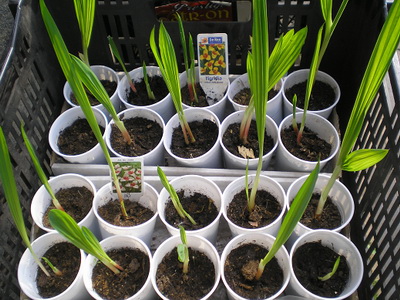
As the bulbs grow, the amount of watering should be increased. Water should completely soak the soil to the full depth. It is important that excess moisture flows onto the pallet, and does not stagnate in the pot, as this can lead to rotting of the planting material.
When germinating tigridia bulbs at home, it is useful to use bottom watering. This will require a wide deep pallet. This type of watering prevents the development of fungal diseases.
Once the bulbs have sprouted, they should be moved to a windowsill where they will be exposed to bright light. Watering is carried out in the same way as before. Landing in open ground can be done after warm fine days are established. It is best to do this work in the first week of June.
For planting sprouted bulbs, shallow pits are made, filled with a drainage layer to prevent water stagnation, and a loose nutrient substrate is laid on top. An onion is placed on it, slightly deepening it, covered with a layer of earth. Transplanted corms are watered abundantly.







